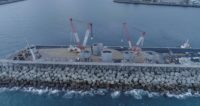As wind farms proliferate in more remote onshore and offshore locations, a U.K. startup is deploying self-piloting drones to survey turbine blades and transmit data to produce detailed images of damage using artificial intelligence. Another technology firm is close to commercializing a robot to make closer damage surveys and undertake repairs.
Once released, the drone orients itself and, depending on conditions, spends about 20 minutes scanning a turbine before returning to its launch point. “All the operator is seeing is a progress bar and images coming through,” says Kostas Karachalios, CEO of drone startup firm Perceptual Robotics.
Detected damage is flagged to a turbine expert for validation. As the company acquires more data, confidence in its machine learning ability will increase, eliminating the need for human interventions, possibly as early as next year, he adds.
Karachalios and two other recent post-graduates from the U.K.'s Bristol University founded the company along in 2016. With $3 million in private backing in the last few years, it has grown to 12 people and could double in size this year, he hopes.
Karachalios says the system detects 10% to 15% more damage than manual surveys, including leading edge erosion that impairs efficiency. By catching faults earlier than by traditional means, the system can save 30% in long-term maintenance costs, he adds.
That level of savings is also claimed by BladeBUG, another sector technology firm, with its autonomous six-legged walking robot. Equipped with a scanner and multiple cameras, the robot can search for damage and undertake relatively small repairs.
In development since 2014, the BladeBUG Crawler robot scans a turbine blade geometry and calculates how to position its feet and legs accordingly. "The operator simply needs to direct it forward, back, left, or right," says CEO Chris Cieslak.
A tether, strong enough to support the robot's weight, connects with the operator's laptop to draw power and transfer data. "In time we will integrate more autonomy for path planning and repair routines," adds Cieslak.
While repair trials have yet to begin, the robot's mobility was demonstrated last year. Over two days, it moved along 50 m of a vertical blade on a demonstration turbine in Scotland and transmitted data from scans. The event represented offshore wind's "moon walk," says Chris Hill, operational performance director of the state-funded turbine owner ORE Catapult.
Since the walking trials on the 60-cm by 60-cm robot, the team has been working on tools including ultrasonic scanners for subsurface inspections and sanding. The company plans to start commercial activities next year, ultimately aiming to provide tools for turbine owners. "We are a robotics company, not a wind turbine service company," notes Cieslak.
He sees the robot as a "follow-up device" to drone surveys such as what Perceptual Robotics has developed. By making physical contact with turbine blades, the robot can undertake more detailed inspection than possible from a drone, agrees Elizabeth Traiger, a senior researcher in digital assurance at DNV AS, the Norway-based assurance and risk management consultant.
Traiger finds BladeBUG "really exciting," but she is directly involved with Perceptual’s drone through a 12 month joint study with Bristol University that started this spring. "We want to create a verification and validation system and informed guidelines," she says.
While national and international standards exist for each element of the system, it's "pick and mix," says Traiger. "It falls under all umbrellas and none of them directly [covers] a self-piloted aviation device which uses artificial intelligence to detect defects."
To win the confidence of turbine owners, developers of the new technology need to show that the same quality of repeatable results can be achieved without the direct involvement of skilled engineers, says Traiger.
While engineers can have different opinions, "this system [introduces] a level of consistency," she adds. "The AI system is learning the collective knowledge of many blade experts."








Post a comment to this article
Report Abusive Comment